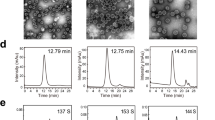Abstract
The recombinant proteins E6-CBD and E7-CBD, which are antigens E6 and E7 of human papillomavirus type 16 (HPV16), were connected by a glycine-serine spacer with the cellulose-binding domain (CBD) of Anaerocellum thermophilum in preparations obtained via synthesis in a heterologous expression system in Escherichia coli. A simple, effective, one-step technology for the isolation and purification of recombinant proteins E6-CBD and E7-CBD has been developed. The presence of antigenic properties in the obtained protein preparations was confirmed via Western blot. Three variants of immunogenic compositions with the recombinant proteins E6-CBD and E7-CBD and a three-dose immunization scheme have been developed. The immunogenicity was assessed in the BALB/c mice, and the antitumor effect of immunogenic compositions was studied on an experimental model of BALB/c mice with HPV16-associated tumors. It is shown that E6-CBD and E7-CBD are highly immunogenic and have antitumor effects in vivo. Both proteins, E6-CBD and E7-CBD, must be present to achieve the highest efficiency as part of the immunogenic composition. The obtained HPV16 recombinant antigens E6-CBD and E7-CBD can be used in two ways: (a) in clinical practice as the main specific components of therapeutic vaccines for the treatment of HPV16-associated neoplastic lesions of various localizations (cervical cancer, carcinoma of the anogenital tract, oropharynx) and (b) in diagnostics for the development of diagnostic kits to detect antibodies to E6 and E7 oncoproteins in patients with HPV16-associated malignant neoplasms.





Similar content being viewed by others
REFERENCES
Vonsky, M.S., Runov, A.L., Gordeychuk, I.V., and Isaguliants, M.G., Biochemistry (Moscow), 2019, vol. 84, no. 7, pp. 800–816. https://doi.org/10.1134/S0006297919070101
Vonsky, M.S., Shabaeva, M.G., Runov, A.L., Lebedeva, N.N., Chowdhury, S., Palefsky, J.M., and Isaguliants, M.G., Biochemistry (Moscow), 2019, vol. 84, no. 7, pp. 782–799. https://doi.org/10.1134/S0006297919070095
Bray, F., Ferlay, J., Soerjomataram, I., Siegel, R.L., Torre, L.A., and Jemal, A., CA Cancer J. Clin., 2018, vol. 68, pp. 394–424. https://doi.org/10.3322/caac.21492
Bruni, L., Albero, G., Serrano, B., Mena, M., Gómez, D., Muñoz, J., Bosch, F.X., and de Sanjosé, S., Human Papillomavirus and Related Diseases Report, ICO/IARC Information Centre on HPV and Cancer (HPV Information Centre), 2019. https://hpvcentre.net/statistics/reports/XWX.pdf.
Liu, Z., Tasnuva, R., and Nyitray, A., Sex. Health., 2016, vol. 13, pp. 10–21. https://doi.org/10.1071/SH15089
Zarochentseva, N.V., Belaya, Yu.M., Samsygina, G.A., Scherbakova, M.Yu., Vyzhlova, E.N., and Malinovskaya, V.V., Lechaschii Vrach, 2017, vol. 4, pp. 56–63.
Hancock, G., Hellner, K., and Dorrell, L., Best Pract. Res. Clin. Obstet. Gynaecol., 2018, vol. 47, pp. 59–72. https://doi.org/10.1016/j.bpobgyn.2017.09.008
Klingelhutz, A.J. and Roman, A., Virology, 2012, vol. 424, no. 2, pp. 77–98. https://doi.org/10.1016/j.virol.2011.12.018
Arbyn, M., Xu, L., Simoens, C., and Martin-Hirsch, P.P.L., Cochrane Database Syst. Rev., 2018, vol. 5. CD009069. https://doi.org/10.1002/14651858.CD009069.pub3
Cheng, M.A., Farmer, E., Huang, C., Lin, J., Hung, C.F., and Wu, T.C., Hum. Gene Ther., 2018, vol. 29, pp. 971–996. https://doi.org/10.1089/hum.2017.197
Yang, A., Farmer, E., Lin, J., Wu, T.C., and Hung, C.F., Virus Res., 2017, vol. 231, pp. 148–165. https://doi.org/10.1016/j.virusres.2016.12.002
Nakagawa, M., Stites, D.P., Patel, S., Farhat, S., Scott, M., Hills, N.K., Palefsky, J.M., and Moscicki, A.B., J. Infect. Dis., 2000, vol. 182, pp. 595–598. https://doi.org/10.1086/315706
Combes, J.D., Pawlita, M., Waterboer, T., Hammouda, D., Rajkumar, T., Vanhems, P., Snijders, P., Herrero, R., Franceschi, S., and Clifford, G., Int. J. Cancer, 2014, vol. 135, pp. 2453–2461. https://doi.org/10.1002/ijc.28888
McIntyre, M.C., Frattini, M.G., Grossmon, S., and Laimons, L.A., J. Virol., 1993, vol. 67, no. 6, pp. 3142–3150. https://doi.org/10.1128/JVI.67.6.3142-3150.1993
Pahel, G., Aulabaugh, A., Short, S.A., Barnes, J.A., Painter, G.R., Ray, P., and Phelps, W.C., J. Biol. Chem., 1993, vol. 68, no. 34, pp. 26018–26025.
Patrick, D.R., Zhang, K., Defeo-Jones, D., Vuocolo, G.R., Maigetter, R.Z., Sardana, M.K., Oliff, A., and Heimbrook, D.C., J. Biol. Chem., 1992, vol. 267, no. 10, pp. 6910–6915.
Imai, Y., Tsunokawa, Y., Sugimura, T., and Terada, M., Biochem. Biophys. Res. Commun., 1989, vol. 164, no. 3, pp. 1402–1410. https://doi.org/10.1016/0006-291x(89)91826-3
Verma, R.R., Sriraman, R., Rana, S.K., Ponnanna, N.M., Rajendar, B., Ghantasala, P., Rajendra, L., Matur, R.V., and Srinivasan, V.A., Protein Expr. Purif., 2013, vol. 92, no. 1, pp. 41–47. https://doi.org/10.1016/j.pep.2013.08.010
Nomine, Y., Ristriani, T., Laurent, C., Lefevre, J.F., Weiss, E., and Trave, G., Protein Expr. Purif., 2001, vol. 23, no. 1, pp. 22–32. https://doi.org/10.1006/prep.2001.1451
Xu, M.L., Kim, S.C., Kim, H.J., Ju, W., Kim, Y.H., and Kim, H.J., Protein Expr. Purif., 2017, vol. 132, pp. 19–26. https://doi.org/10.1016/j.pep.2017.01.004
Sambrook, J., Fritsch, E.F., and Maniatis, T., Molecular Cloning: A Laboratory Manual, New York, N.Y.: Cold Spring Harbor Laboratory Press, 1989.
Lyaschuk, A.M., Lunin, V.G., Karyagina, A.S., Lavrova, N.V., Rodionova, I.V., Kormilitsyna, M.I., et al., Zh. Mikrobiol. Epidemiol. Immunobiol., 2006, vol. 4, pp. 65–68.
Sergienko, O.V., Lyaschuk, A.M., Aksenova, E.I., Galushkina, Z.M., Poletaeva, N.N., Sharapova, N.E., et al., Mol. Genet. Mikrobiol. Virusol., 2012, no. 1, pp. 16–20.
Velikodvorskaya, G.A., Tikhonova, T.V., Gurvits, I.D., Karyagina, A.S., Lavrova, N.V., Sergienko, O.V., et al., Appl. Environ. Microbiol., 2010, vol. 76, pp. 8071–8075. https://doi.org/10.1128/AEM.01517-10
Fernando, G.J., Murray, B., Zhou, J., and Frazer, I.H., Clin. Exp. Immunol., 1999, vol. 115, pp. 397–403. https://doi.org/10.1046/j.1365-2249.1999.00813.x
Petrone, L., Ammendolia, M.G., Cesolini, A., Caimi, S., Superti, F., Giorgi, C., and Di Bonito, P., J. Transl. Med., 2011, vol. 9, no. 69. https://doi.org/10.1186/1479-5876-9-69
Funding
The work was performed within the framework of the state assignment of the Centre for Strategic Planning of FMBA of Russia, no. 388-00102-20-01.
Author information
Authors and Affiliations
Corresponding author
Ethics declarations
Conflict of interest. The authors declare that they have no conflicts of interest.
Statement on the welfare of animals. All procedures involving laboratory mice line BALB/c were performed in accordance with ethical principles adopted by the European Convention for the protection of vertebrate animals used for experimental and other scientific purposes (European Treaty Series, no. 123).
Additional information
Translated by A. Ostyak
Rights and permissions
About this article
Cite this article
Subbotina, M.E., Grunina, T.M., Sergienko, O.V. et al. Recombinant Antigens E6 and E7 of Human Papilloma Virus Type 16: Preparation, Purification, and Assessment of the Immunogenicity and Antitumor Effects In Vivo. Appl Biochem Microbiol 57, 392–402 (2021). https://doi.org/10.1134/S0003683821030121
Received:
Revised:
Accepted:
Published:
Issue Date:
DOI: https://doi.org/10.1134/S0003683821030121




